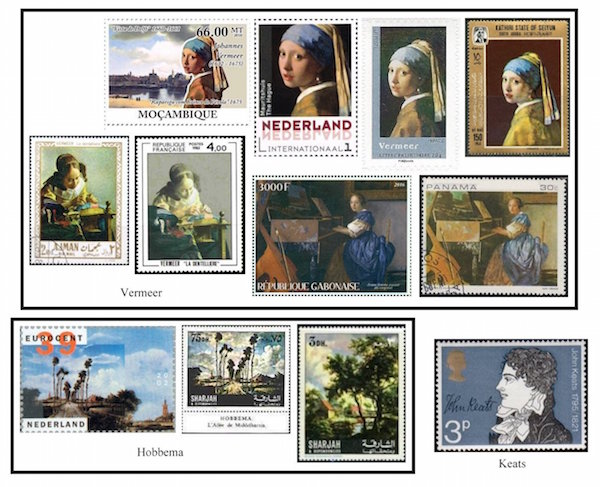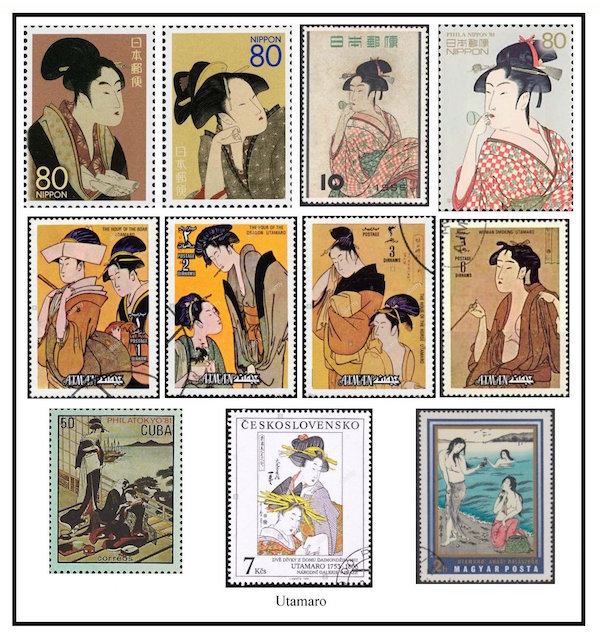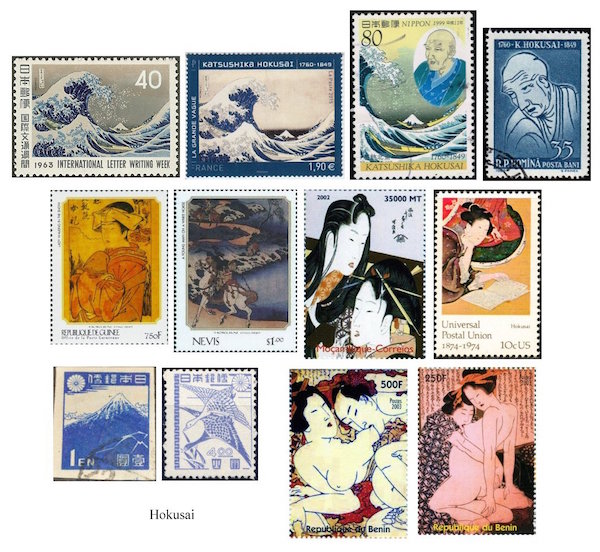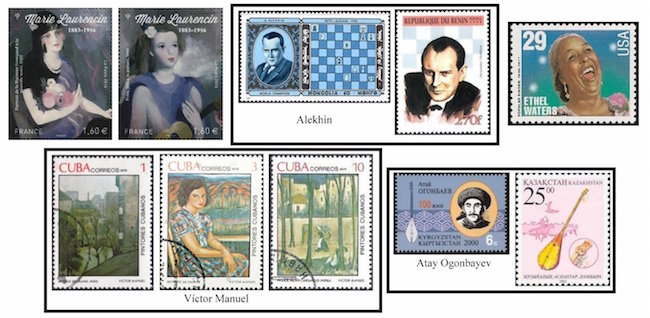The Arts on Stamps of the World — October 31
An Arts Fuse regular feature: the arts on stamps of the world.

By Doug Briscoe
Two great Dutch painters, Vermeer and Hobbema, happen to have been baptized on the same day, October 31, six years apart, and one of the greatest of Japanese painters, Hokusai, may have been born on this date. It is definitely the birthday of one of the greatest of poets, John Keats, and among our other honorees today are Maria Mercouri, John Candy, Peter Jackson, and chess grandmaster Alexander Alekhin.

One of the best loved of artists in our own time (as the profusion of stamps clearly demonstrates), Johannes Vermeer was relatively little known in his own and largely forgotten after his death until the 19th century. He was baptized on this day in 1632 in Amsterdam, lived most of his life in Delft, and was buried on 15 December 1675. Before we move on to the pictures, a few interesting facts: of the 34 paintings definitively attributed to him, most depict two rooms of his home; though not at all wealthy, he used very costly pigments; he had fifteen children, of whom eleven survived him. Contrary to my usual practice, I for the most part won’t bother to provide links to larger images of the paintings as they are already so familiar. One exception is A Girl Asleep (1656-7), selected for a minisheet from Togo. One of Vermeer’s few exteriors, The Little Street (1657-58), is on one of a set of four stamps from the Netherlands Antilles. The others are Woman in Blue Reading a Letter (1663-4), also seen on stamps of France and Aitutaki, The Love Letter (1669-70), and The Milkmaid (c1658), which also shows up on stamps of Rwanda and Yemen. The collage concludes with The Girl with the Wineglass (c1659) on a German stamp issued just this year. On a Mozambique stamp View of Delft (1659-60) is paired with the famous Girl with a Pearl Earring (1665), made even more famous by Tracy Chevalier’s 1999 novel and its film adaptation (2003), so we offer a few more stamps highlighting the painting. These are followed by two examples each of The Lacemaker (1669-70) and Lady Seated at a Virginal (1673-75) represented on stamps of Gabon and Panama. I would never have guessed that Diana and Her Companions (c1653-4, no stamp) was an early Vermeer. In the cross-pollination department, Dutch composer Louis Andriessen wrote an opera about the artist, Writing to Vermeer (1997-98), to a libretto by Peter Greenaway!
Poor Meindert Hobbema, baptized six years to the day after Vermeer (in 1638), and in the same city of Amsterdam, does not fare nearly so well on stamps. Hobbema’s work was almost exclusively in landscape painting, and in woodlands in particular, though his most famous piece, The Avenue at Middelharnis (1689) does not fit the pattern with its neat rows of trees on either side of a road. The stamp from the Netherlands doesn’t fit the usual pattern, either—it takes the unusual approach of presenting a dual view of the painting, the entirety being superimposed over a close-up of the spire in the distance. The same painting appears on a stamp of Sharjah, and The Mill (1692) is shown on another. Hobbema’s bio in brief: his father’s name was Meyndertsz, but for reasons unknown he adopted the name Hobbema; he a was a pupil of Jacob van Ruisdael; after his marriage in the late 1660s his output declined, mainly, it seems, because of his employment as a “wine-gauger” (collector of excise taxes on wines); after 1689, that is, for the last twenty years of his life, it appears he painted not at all; he died on December 7, 1709. Even less well known during his lifetime than Vermeer was, he had a similar posthumous reputation: forgotten for a century, reassessed (somewhat sooner than Vermeer) in the late 18th century.
One of the greatest English poets, John Keats, whose sublime verses have been set to music by a great many composers, mostly British and American, was born on October 31, 1795. His father died in a fall from a horse when Keats was 8 and his mother from tuberculosis when he was 14. He and his siblings were brought up by their grandmother. Keats studied medicine and even worked as a surgeon’s assistant in a hospital, but his longing for literature was too great. His first published poem appeared in Leigh Hunt’s journal The Examiner in 1816, and the next year saw the printing of his first poetry volume (which made little impression). He may have contracted tuberculosis from his brother Tom, who died of the disease in 1818. Keats went to Rome for the climate in the autumn of 1820 and never saw England again. John Keats died of tuberculosis at age 25 on February 23, 1821. My personal favorite Keats setting is the gorgeous sonnet “To Sleep” (“O soft embalmer of the still midnight”) from Benjamin Britten’s Serenade, but that poem was also set by Mario Castelnuovo-Tedesco (!), Carlos Chávez (!), Healey Willan, and Egon Wellesz, among others. Among the innumerable other composers who have been inspired by Keats are George Antheil, Dominick Argento (who just had his 90th birthday on the 27th), Jack Beeson, Frank Bridge, David Diamond, Hamilton Harty, Gustav Holst, Charles Ives, Elizabeth Maconchy, Roger Quilter (whose birthday is tomorrow, but no stamp), and William Schuman. “La belle dame sans merci” alone was set by Geoffrey Bush, Frederick Shepherd Converse, George Dyson, Cecil Armstrong Gibbs, Patrick Hadley, Paul Hindemith, Joseph Holbrooke, Hubert Parry, Wallingford Riegger, Edmund Rubbra, Cyril Scott, Charles Villiers Stanford, and Louise Talma, most of whom also set other Keats texts as well.

Not only do we have two great Dutch painters on today’s edition, but two great Japanese as well, and they, too, were contemporaries of each other. The older was Kitagawa Utamaro (c1753 – 31 October 1806), one of the most respected ukiyo-e woodblock designers. In the middle of the 18th century, full-color prints began to appear in abundance in Japan; these were made by using a different woodblock for each color of the design. Utamaro’s earlier work was of this kind, intended mostly for books. In about 1791 he turned from this to embark on a series of portraits of individual women, whom he tended to represent with elegant long heads, as in Woman Wiping Sweat (Ase o fuku onna, 1798) and the first two Japanese stamps, called, respectively, Love that Meets Each Night and Reflective Love (c1793–94). The other two Japanese stamps, one from 1958, the other from 2001, show the same piece, A Girl Whistling a Vidro (glass toy). Of course, not all of the Utamaro stamps originate in Japan; quite the contrary. The next set of four is a lovely group from Ajman: The Hour of the Boar, The Hour of the Dragon, The Hour of the Horse, and the enticing Woman Smoking; then we have Idyll in a Teahouse from Cuba, Two Maidens (1802) from Czechoslovakia, and Awabi Fisher Women on a 1971 stamp from Hungary. Utamaro also illustrated books of insects and other nature studies.
Utamaro’s contemporary, much better known in the west, was Katsushika Hokusai. He was born in Edo into a family of artisans on a date that is thought to have been October 31, 1760. A tradition among Japanese artists of the day was to use various names at various points in their lives, but Hokusai, who was born Tokitaro, carried this practice to an extraordinary extreme, using as many as thirty different pseudonyms. He began to paint when he was about six, went to work in a bookshop at 12, and was apprenticed to a woodcarver at 14. At 18, he joined the studio of ukiyo-e artist Katsukawa Shunshō (1726 –1793). After the master’s death, Hokusai began exploring Western art through imported French and Dutch copper engravings and turning from a concentration on portraits to new subjects: landscapes and pictures of daily life. Around 1800 he started using the name by which we know him best, Hokusai (meaning “north studio”), but by the time he created the work that is most famous to us, Thirty-six Views of Mount Fuji (c1831), he had started calling himself Gakyo Rojin Manji (The Old Man Mad About Art). And the most famous print from this famous collection is The Great Wave off Kanagawa, which we see on stamps of Japan, one with Hokusai’s portrait, and France. Another portrait of the master appears on a stamp from Romania, and other postal services that have joined the Hokusai bandwagon include Guinea (Lady Walking in the Snow), Nevis (A Young Man on a White Horse), Mozambique (Girls at Their Toilette), and, yes, the United States (Five Feminine Virtues). Two Japanese stamps using Hokusai images that came out right after the war are Thunderstorm Below Fuji (1946) and First Geese (1947). I cannot leave the subject without discussing the very naughty shunga. Shunga is erotic art, and Hokusai dabbled, if that’s the word for it, in that genre as well, as exemplified by two, um, saporous stamps from Beninese minisheets. Hokusai worked well into old age, dying aged 88 on May 10, 1849.

Today’s fifth painter and third consecutive printmaker is Marie Laurencin (31 October 1883 – 8 June 1956), born in Paris. She became the muse of Guillaume Apollinaire, and also enjoyed romantic relationships with other people of both sexes, among them the expatriate American writer Natalie Clifford Barney. After studying porcelain painting in Sèvres in her late teens she found herself in artistic circles and was well acquainted with such figures as Picasso and Cubists of the Section d’Or, with whom she exhibited beginning in 1910. She lived in Paris all her life, except during and just after the First World War, when she and her husband were in Spain and then briefly in Düsseldorf; after their divorce in 1920 she returned to the city of her birth and there remained. Laurencin left paintings, drawings, and prints. Among them are her Portrait of the Baroness Gourgaud in a Black Mantilla (1923) and Little Girl with Guitar (1940), shown on stamps on her native France.
One of the greatest of chess masters was Alexander Alekhin (October 31 [O.S. October 19] 1892 – March 24, 1946), who, after leaving Russia in 1921, settled in France, where an “e” was appended to his last name. In 1925 he accomplished the astonishing feat of playing 28 simultaneous games while blindfolded. He lost only three, with three draws. Alekhine was the fourth official World Chess Champion on his defeat José Raúl Capablanca in 1927 (the same year in which his French citizenship was granted) and is the only champion to have died while still holding the title. He also received a law doctorate from the Sorbonne. Besides his many brilliant performances, he is remembered for the chess opening named for him, Alekhine’s Defence (1.e4 Nf6).
A very different kind of creative beauty was achieved by American blues, jazz, and gospel singer Ethel Waters (October 31, 1896 – September 1, 1977). Waters also achieved quite a number of “firsts”: the first African-American woman to appear in an integrated Broadway production (As Thousands Cheer, 1933), the first to star on her own television program (The Ethel Waters Show, a one-off special, in 1939!), the first to lead a weekly TV show (Beulah, carried over from radio, 1950-51), and the first to receive an Emmy nomination (1962). Waters was born in Pennsylvania, a child of rape. For a time, Ethel used the name Howard (her mother’s husband) before deciding on that of her natural father. She herself was briefly married at 13. She worked as a maid until happenstance brought her to the stage of a nightclub, where her obvious talent got her a gig at the Lincoln Theater in Baltimore. She also worked in a carnival, with which she traveled south to Atlanta and there found work singing in the same club with Bessie Smith. Harlem followed, and soon Waters was making records, one of which, “Dinah”, became a hit. Another song, “Am I Blue?”, was used in a 1929 movie and became Waters’s signature song. In 1933, Waters herself starred in an all-black short, Rufus Jones for President, in which 7-year-old Sammy Davis Jr. appeared as the title character. Waters also performed at the Cotton Club. She was nominated for a Best Supporting Actress Oscar for Elia Kazan’s film Pinky (1949) and won the New York Drama Critics Circle Award the next year for her role on stage in The Member of the Wedding opposite Julie Harris. In her later years, Waters also toured with Billy Graham.
Now, after a side trip to chess and music, it’s back to painting with Víctor Manuel García Valdés (October 31, 1897–February 1, 1969), who used his full name as his signature until dissuaded by his French colleagues. He was born in Havana and was seen to exhibit striking drawing ability at the age of six. At 12 he entered Cuba’s most prestigious art school, becoming a teacher himself at 18. He had his first solo exhibit at 26 (in 1924) and went the next year to Paris. He was an exponent of the Vanguardia movement, which combined elements of European Modernism with native Cuban influences. His most famous painting is La Gitana Tropical (The Tropical Gypsy, also known as La Gioconda Americana—The American Mona Lisa, 1929). From a set of Cuban stamps I show three other canvases by Manuel: Avenue du Maine, Paris; Portrait of Enmita; and Woman Carrying Hay. These are, frankly, rather less characteristic than La Gitana Tropical.

Also born on October 31 was the Kyrgyz folk musician Atay Ogonbayev (1900-1949). Besides writing love songs that are enormously popular in his native region, he played the komuz (or qomuz, an example can be seen on the stamp) and founded and directed the Kyrgyz Komuz Ensemble. Wikipedia describes the komuz as “an ancient fretless string instrument used in Central Asian music, related to certain other Turkic string instruments and the lute.” I add another stamp showing the komuz from neighboring Kazakhstan.
There are those who hold that Carlos Drummond de Andrade (October 31, 1902 – August 17, 1987) is the greatest Brazilian poet. Certainly one of his great admirers is Boston’s own Lloyd Schwartz, who has translated some of Drummond’s work. He was born in a mining village to a descendant of an emigré Scottish family and mostly earned his living as a civil servant, rising to the position of director of history for the National Historical and Artistic Heritage Service of Brazil. As a modernist poet he found inspiration in the works of his namesake Mário de Andrade (no relation). His image and poem “Canção Amiga“ (“Friendly Song”) were featured on the short-lived 50-cruzado novo bill (1989-90).
Greek actress and singer Melina Mercouri (31 October 1920 – 6 March 1994) became active in politics following her acclaimed career on the stage and in film. Originally she was Maria Mercouri. She was graduated from the National Theater’s Drama School in 1944 and had her first big success as Blanche DuBois in A Streetcar Named Desire in 1949. She lived in Paris from 1950 to 1955 and, on her return, made her first film appearance in the Greek language film Stella (1955), directed by Michael Cacoyannis. In this country she’s probably best known for her performance in Never on Sunday (1960), for which she won the Best Actress award at Cannes and was nominated for an Oscar. On the political side, Mercouri was the first female Minister for Culture of Greece after her retirement from film in 1978. She went on acting on the stage until 1992. Because our page is ridiculously overcrowded today, I show just two of four Mercouri stamps from a 1995 set.

The marine biologist Frederick Bayer (October 31, 1921 – October 2, 2007) earns a spot here on AoSofW because of his illustrations. Emeritus curator of the Smithsonian Institution’s National Museum of Natural History, Bayer designed marine scenes that were used in a set of Haitian postage stamps in 1973. We see one of these. As a child in south Florida he collected seashells and developed into an amateur naturalist. While serving as a photographic technician in the Pacific during World War II, Bayer would collect and make many sketches of marine fauna and butterflies all through the region. With a doctorate in taxonomy he worked at the Smithsonian off and on for 35 years (1947-61 and 1975-96). A hydroid found in the bay of Panama, Hydractinia bayeri, was named for him in 1984 by fellow marine biologist the Emperor Hirohito!
Russian actor Anatoli Papanov (31 October 1922 – 7 August 1987) joined a drama circle while still in school, but worked in a factory and then served in World War II before becoming a professional actor. He was severely wounded in the war, afterward building a reputation on the stage of the Moscow Theater of Satire. In films he was associated mostly with comedy roles, but also took on some dramatic ones. He often worked on screen with his close friend Andrei Mironov. One of Papanov’s most celebrated roles was in the film The Alive and the Dead (1963), directed by Aleksandr Stolper. Papanov died of heart failure just nine days before Mironov.
Pakistani artist Zubaida Agha was born at some unspecified point in the year 1922 and died on this date in 1997. A pioneer of abstract painting in Pakistan, she was the first artist (of either sex) to have an exhibition of her paintings. Born at Faislabad, she attended Kinnaird College in Lahore and made the acquaintance of the work of Picasso through a fortuitous circumstance while she was in India, having had contact with an Italian prisoner of war who was knowledgeable on the subject. As early as 1946 she received first prize for modern painting from the Society of Fine Arts. She undertook further studies in London and Paris in 1950-51. In 1961 Agha became executive director of the Contemporary Art Gallery in Rawalpindi. One of her paintings is called Beethoven’s Fifth Symphony. I can’t find a picture of it online, nor can I identify the painting shown on the stamp, but I provide a link to her Evening (1980).

I remember being saddened by the early death of Canadian comedian and actor John Candy (October 31, 1950 – March 4, 1994), who struggled with obesity and succumbed to a heart attack when he was 43. Candy was born in Ontario and studied journalism. He started working in films as an actor in 1973, on TV in 1975, and as a cast member of Second City Television in 1976. At the time of his death he was considering taking on the role of Ignatius J. Reilly in an adaptation of John Kennedy Toole’s novel A Confederacy of Dunces. That would’ve been something to see. What a shame that Candy was circumvented by his valve!
New Zealand director Sir Peter Jackson (born 31 October 1961) has a lot of stamps because the postal service of his country saw dollar signs in making stamps of his blockbuster films (no complaints here, as I’ve been using them to pay tribute to a goodly number of actors, including, of course, Ian McKellen). Today I show stamps that do not feature recognizable thespians, but rather other images from the films.
A graduate of the University of Massachusetts with a B.A. in English, Doug Briscoe worked in Boston classical music radio, at WCRB, WGBH, and WBUR, for about 25 years, beginning in 1977. He has the curious distinction of having succeeded Robert J. Lurtsema twice, first as host of WGBH’s weekday morning classical music program in 1993, then as host of the weekend program when Robert J.’s health failed in 2000. Doug also wrote liner notes for several of the late Gunther Schuller’s GM Recordings releases as well as program notes for the Boston Classical Orchestra. For the past few years he’s been posting a Facebook “blog” of classical music on stamps of the world, which has now been expanded to encompass all the arts for The Arts Fuse.
